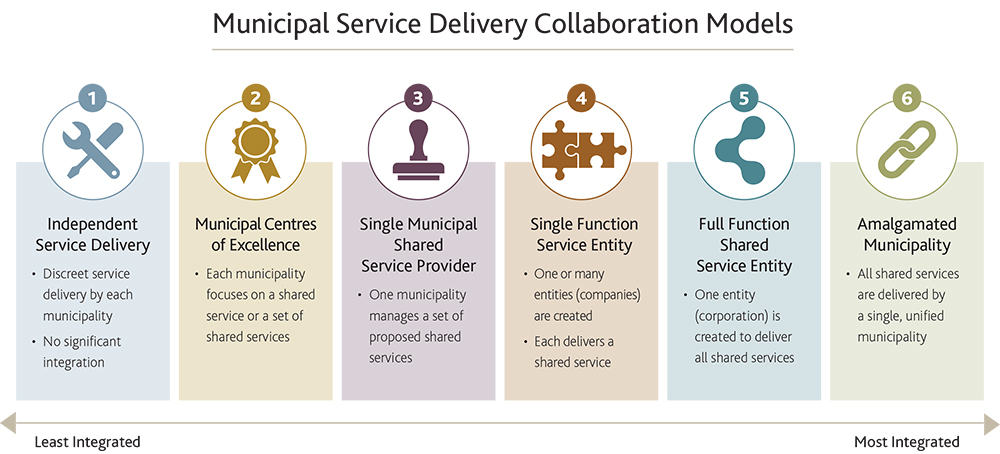Part 2 – Alternate Solutions and Successful Transitions
Canadian municipalities face increasing pressure to transform their service delivery models to meet evolving citizen expectations while grappling with decreasing resources. Part 2 of Updating the Municipal Model presents a spectrum of opportunities for collaboration, from maintaining independent service delivery on one end to fully amalgamating with other municipalities on the other

Independent Service Delivery — Each municipality delivers discreet services to their citizens. It is important to note there is a recognition and acceptance of eroding boundaries, as citizens demand service regardless of where they live.
Municipal Centres of Excellence — Each municipality takes on a specific service and develops shared service agreements with other municipalities to operate and manage the service. For example, one municipality might take on local road maintenance while another municipality takes on solid waste management.
Single Municipal Shared Service Provider — One municipality takes on the delivery of all proposed shared services and develops shared service agreements with other municipalities. This leaves the municipalities to focus on their “core business.” A model for this is one municipality takes on all the corporate shared services such as human resources, materials management and IT, and leaves the delivery of on-the-ground services with the individual municipality.
Single Function Municipally-Owned Corporate Service Entities — One or many service entities are created by the municipalities (potentially as “Part 9 corporations”) with boards guiding each entity and comprised of members from each municipality. Each entity would focus on specific services and contract directly with each municipality. Several jurisdictions have done this in the waste and utility services, for example, Beaver County in Alberta. Innovation in this area would be to look at shared or direct citizen services.
Full Function Municipally-Owned Shared Service Entity — A single regional entity (municipally-owned corporation) operates with a mandate to provide all the shared services envisioned by the municipal owners. A board comprised of council members or delegates from each partner municipality provides guidance to the corporation. Service contracts are established with each municipality, according to their needs.
Amalgamated Municipality — In some jurisdictions it has made sense to join into a single municipal organization and provide services across the region in a unified manner through traditional municipal structures and organizations. Successful examples of this include Crows Nest Pass, Regional Municipality of Wood Buffalo, and Strathcona County. Flagstaff County is working through the consolidation of its regional governance model today.
KEY CONSIDERATIONS
Transforming how municipal services are delivered and under what model offers challenges as well as opportunities for governments seeking to run their communities more efficiently while keeping their citizens happy. It requires operational as well as financial shifts, and often a change in mindset – for both executives and citizens.
Weighing in on Change
- Services and Service Delivery
- Finances and Taxes
- Optimizing Growth and Quality of Life
- Regional Pressures
- History and Identity
- Political Context
One of the first issues elected officials and managers consider is how taxes and mill rates would be affected under the different governance models, and how future growth could be impacted. The immediate and long-term risks and benefits to stakeholders – residential, commercial, industrial and resource-based businesses – will vary under different models and must be reviewed to ensure a change will be beneficial.
But finances are just the beginning. Different service delivery models have implications on future growth and citizens’ quality of life within the community. A reliable overview of trends and forecasts and how they intersect with the municipality’s strategic plan could provide valuable information to support any change.
Insights into key external pressures in your region will also influence a decision and if changes to a service delivery model would support the region’s economic position. On the cultural side, concerns about maintaining a municipality’s unique identity and sense of community could prove to be roadblocks if not appropriately addressed. This also includes reviewing if citizen engagement will change under a new system and if the value of their voices and vote - and elected officials’ - will be preserved.
Municipalities have a number of options to increase their efficiency and effectiveness in a world often just focused on amalgamation. Thorough and comprehensive research and planning will help understand the choices and pave the way toward a successful transition and sustainable future.
For more information, contact Chris Lavin, Partner, Public Sector Services, at 780.733.8640 or [email protected]






